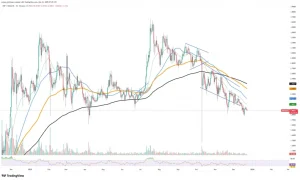Ethereum Stablecoin Transactions Hit Record Rs. 233 Trillion in October, Underscoring Network’s Expanding Role in Global Finance

Ethereum’s dominance in the digital payments ecosystem reached a new milestone in October, with stablecoin transaction volume hitting a record US $2.8 trillion (around Rs. 233 trillion). This unprecedented figure reflects Ethereum’s growing role as the primary settlement layer for dollar-pegged digital assets such as USDT and USDC. Analysts attribute this surge to increased adoption across decentralized finance (DeFi), remittances, and institutional settlements. While Bitcoin continues to dominate the store-of-value narrative, Ethereum’s network utility and transaction activity demonstrate its evolution into a financial backbone for the global crypto economy.
1. A Landmark Month for Ethereum Transactions
Ethereum recorded US $2.8 trillion (approximately Rs. 233 trillion) in stablecoin transaction volume during October, marking the highest monthly figure in the network’s history. This surge represents not just speculative trading but a steady increase in real-world use cases, from on-chain settlements to cross-border payments and decentralized exchanges.
The figure also highlights Ethereum’s continued supremacy in the stablecoin ecosystem, accounting for more than 50% of total stablecoin volume across all blockchains. While rival networks such as Tron and Binance Smart Chain (BSC) have attracted growing user bases, Ethereum remains the preferred infrastructure for large-scale and institutional-grade digital transactions.
2. Why Stablecoins Are Driving Ethereum’s Growth
Stablecoins—digital tokens pegged to fiat currencies like the US dollar—have become essential to the global crypto economy. They provide liquidity, reduce volatility risk, and enable seamless transfers between platforms without relying on traditional banking systems.
Ethereum, with its mature infrastructure and vast network of DeFi applications, serves as the natural habitat for these assets. Popular stablecoins such as Tether (USDT), USD Coin (USDC), and DAI rely heavily on Ethereum’s blockchain for issuance and settlement.
The recent volume explosion can be linked to three major trends:
- Rising institutional use: Hedge funds and fintech firms are increasingly using stablecoins for on-chain settlements and yield-generating activities.
- DeFi expansion: Platforms offering lending, staking, and liquidity provision continue to drive massive stablecoin movement.
- Global remittances: Individuals in emerging economies are turning to stablecoins as an alternative to traditional money transfer systems due to lower costs and faster settlements.
3. The Role of Layer-2 Solutions
Ethereum’s record-breaking month coincided with the rapid adoption of Layer-2 scaling networks, such as Arbitrum, Optimism, and Base. These solutions enable users to conduct high-speed, low-cost transactions while benefiting from Ethereum’s underlying security.
Much of October’s stablecoin volume was facilitated through these Layer-2 systems, which have become crucial in addressing Ethereum’s scalability challenge. By reducing transaction fees and congestion, they have made stablecoin transfers more practical and accessible for everyday users and institutional entities alike.
This evolution underscores Ethereum’s strategic shift from a congested network of DeFi projects to a robust, multi-layered financial infrastructure capable of handling trillions in monthly volume.
4. Institutional and Regulatory Factors at Play
Institutional adoption has become a central force behind the surge. Several payment firms, asset managers, and blockchain-focused banks have integrated stablecoin rails into their operations, using Ethereum as the underlying ledger for settlements.
Additionally, regulatory clarity in jurisdictions such as Hong Kong, Singapore, and the European Union has further legitimized stablecoin usage. Clearer frameworks for tokenized assets have encouraged corporates to test Ethereum-based stablecoin payments as part of broader digital asset strategies.
Experts also note that stablecoins have begun to fill the gap left by traditional banking networks, particularly in cross-border commerce. This growing utility cements Ethereum’s role as a “digital SWIFT” for decentralized finance and international settlements.
5. Comparing Ethereum’s Performance to Bitcoin
While Bitcoin remains the market’s largest cryptocurrency by capitalization, Ethereum’s utility-driven growth is defining a different form of dominance. Bitcoin continues to function primarily as a store of value and hedge against inflation, whereas Ethereum’s network activity reflects active capital flow—comparable to a decentralized banking system in motion.
In October, Ethereum’s transaction throughput and value transfer outpaced Bitcoin by a significant margin, reinforcing the view that the two assets serve complementary rather than competing purposes. Bitcoin may anchor the macro narrative, but Ethereum increasingly drives the day-to-day liquidity engine of the digital economy.
6. Risks and Challenges Ahead
Despite its record performance, Ethereum faces critical challenges that could impact future growth. High gas fees during network congestion, potential regulatory scrutiny over stablecoin reserves, and competition from faster blockchains like Solana and Avalanche remain ongoing concerns.
Furthermore, global economic uncertainty—particularly fluctuations in the US dollar and interest rate policies—could influence stablecoin demand. If macroeconomic pressures intensify, risk-averse investors may temporarily pull capital out of DeFi markets, slowing Ethereum’s transaction momentum.
Still, Ethereum’s proven resilience, ongoing technological upgrades (including the upcoming Danksharding initiative), and strong developer community suggest a long-term trajectory toward stability and scalability.
7. The Road Ahead: Ethereum’s Expanding Financial Footprint
The milestone of US $2.8 trillion (Rs. 233 trillion) in stablecoin volume is more than a record—it’s a reflection of Ethereum’s growing role in the global financial system. With institutional confidence strengthening and infrastructure innovation accelerating, the network is evolving from a speculative playground into a foundational layer of digital finance.
As blockchain-based payments, tokenized assets, and programmable money gain wider acceptance, Ethereum is positioned to become the settlement standard for the decentralized economy. The October record could well be a preview of what the next phase of crypto adoption looks like—where digital assets are not just traded, but truly integrated into the fabric of global commerce.




